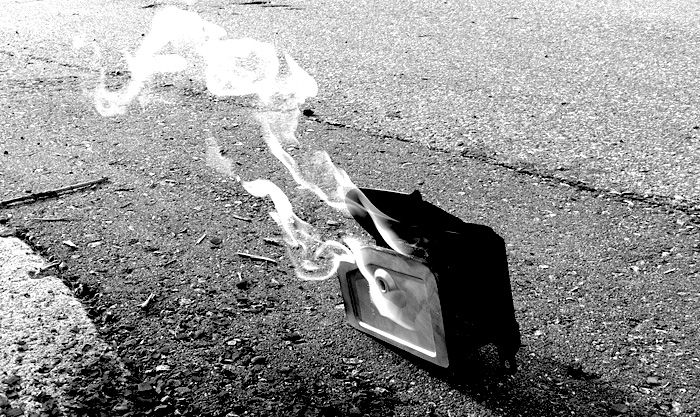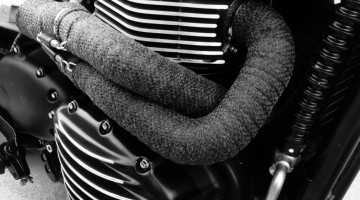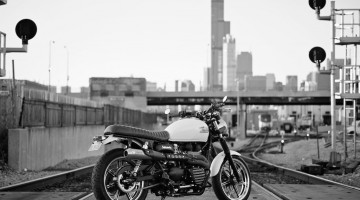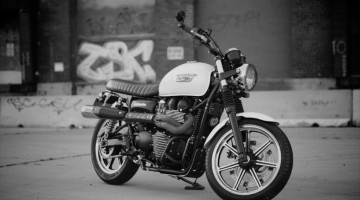For all Jeff’s instruction, there are still times when I feel out of my depth on a motorcycle project. In early July, after months of tearing into the my 1974 Honda CB450 Supersport, we finally had the machine back together. It was even running, though it wasn’t quite ready to ride. Between the 2-into-1 race style exhaust and the aftermarket foam filtration, there was just too much air coming into the motor. We needed to re-jet the carbs. Unfortunately, while I understood the concepts involved, I had no idea how to go about it correctly. With just a little more than a week remaining before the Bearded Lady Motorcycle Freak Show (my intended unveil event), I was running out of options.
Jeff had already been so generous with his time, I didn’t feel right making my personal deadlines his further time suck. Asking him to jet the CB450, for me, seemed like way too much to ask at that point. I had one option remaining — something to tide me over and get me through Bearded Lady. I could go back to stock filtration and try to get the bike closer to proper mixture that way. This would prove to be tantamount to bringing the mountain to Muhammad. There was one main problem with this approach: I didn’t have stock filters. Not clean ones, anyway. That, and I was missing part of one of the CB450’s two airboxes. With all the time and effort spent rebuilding the top end of the engine and the carburetors, I wasn’t about to put dirty old filters on the thing. Without the complete airbox though, I’d be pulling in too much air again, and that would have be back where I started.
I don’t know what Honda was thinking, but or some reason, the CB450 has a needlessly complicated air intake assembly. There’s a dedicated airbox and filter for each side (for each carburetor), and that airbox is made up of a permanent outer box half, and a disposable inner box half that contains the air filter. So each time you change the filter, you actually change half of the airbox as well. This was fine in 1974 when you could still buy replacements. In 2011 it’s a problem because Honda doesn’t make replacement filters anymore. This leaves me with a catch 22. I can have a complete airbox and dirty filters, or no airbox and clean aftermarket filters, but not both. So my only option was to attempt to rebuild the stock filters I did have, and hope the airflow was something close to stock. Maybe then the bike would run well enough to get me out to Bearded Lady and back. Jeff and I could then sort it all out for good after the event.
With The Mrs away for the weekend, I had two straight days where I need do nothing else but rebuild air filters and feed the dogs. That’s pretty much exactly what I did. It was a four step process:
1. Order a new outer airbox on eBay and hope it got there in time
2. Tear the dirty old paper out of the inner air boxes
3. Figure out some sort of new filter element to replace the old paper
4. Fabricate a temporary stand-in for the outer airbox I didn’t yet have
Finding the part on eBay was easier than I thought it would be. So many people are putting pod filters on their older japanese bikes (without then properly tuning their carburetors, unfortunately) that stock intake parts are pretty easy to come by. Unfortunately, there weren’t any new-old-stock filters to be had. With that on the way, it was time for filter demolition. Since the rest of the filter assembly was chromed steel. I opted for the easy way to remove the paper: fire!
Don’t try this at home, kids.
Rather than digging and picking at the paper for hours on end, I opted to spray the paper down sopping wet with carb cleaner and set it aflame. As you can see in the photo, the fire was, shall we say, vigorous. A few quick blasts of cleaner in strategic areas let me fuel the fire and direct the flame. Within about 90 seconds, the paper filter element was reduced to ash and I was able to knock the entire filter element out with a pair of pliers and my gloved fingers. Easy stuff. Now the only trick was finding a replacement element material.
I went down a couple of dead ends. After raiding the filter aisle at the local O’Reilly’s for donor paper filters, I used my band saw to cut a car filter down to the width I needed. The only problem was the height of the pleats. On the OEM Honda filter, the paper pleats were about half an inch each. On the car filter, they were closer to an inch. I thought no problem, I’ll just fold the pleats over each other to make room. What I didn’t realize until hours later (and LOTS of folding) was that by doubling over the pleats, I’d likely gone too far in the opposite direction of where I was trying to go. I’d created a filter element that was too dense. There was no way this now thick wall of paper would have the same flow as stock. Unfortunately, this didn’t dawn on me until I had both filters glued up with Gorilla Glue and basically finished. If only there were an easy way to remove the paper…
The solution I ended on was even more stupid, in retrospect. I went with a single, flat layer of filter paper, then a layer of 1/2″ lawn mower filter foam. My logic was that the foam wouldn’t be dense enough, but a single layer of flat filter paper should restrict the airflow just enough to get me proper airflow. If it was too restricted, I could just remove the foam. They looked good. Not bad for homemade, anyway. I had 2/3 of the equation and now I just needed an outer airbox. As if this project hadn’t been crafty enough, the best solution I had at hand for an airbox was actually cardboard. I had the 1/8″ cardboard box from a little R/C motorcycle I’d taken apart as part of Project Streetliner. It was the perfect thickness to stand in for the 450’s plastic outer airbox.
With just scissors, a bottle of super glue and a can of glue catalyst, I used the one airbox I did have to make a mirror image twin out of thin cardboard. After nearly two days of folding, gluing, trial and error — my improvised airbox came together from nothing in about 45 minutes. At the time, I couldn’t think of anything I’d ever made that I was more proud of. It was airtight, correctly shaped, and it fit the filter element like a glove. It wasn’t pretty, but it just might work. It just might get me to Bearded Lady.
Monday morning, I put both now complete filter boxes in my car so that I could swing by BlueCat Motors on my way home from work. The whole day was spent counting the hours until I could get back to St. Paul and see if all my homespun engineering had been successful. When I finally walked through the door, I was proud of those improvised air boxes like they were my own prize-winning children. They were mechanically feasible, well executed, but most of all, completely my own creation. I borrowed a screwdriver from Jeff and installed them straight away. The 450’s side cover wouldn’t quite fit over my improvised outer airbox, but that was okay. This was just to test and see if I’d gotten close enough on the air delivery side to keep us from having to jet the carbs. With fingers crossed, I turned on the fuel and hit the starter.
Sure enough, the CB450 ran. It didn’t run great, but it ran. It was soon obvious that the poor thing was gasping. Not enough air. We pulled the spark plugs and sure enough, the mixture was richer than cheesecake. With new plugs in place, I pulled the airboxes apart quickly and tore the foam free — my layer of flat paper would be enough filtration to get me through the week. Firing the bike back up, I’d missed again. The idle was hanging badly, the sharp, eye-burning smell of lean exhaust filled the shop.
Failure.
I was back where I’d started. The bike was too lean, and I wasn’t equipped to do anything about it. What’s more, beyond just running lean, the engine sounded terrible. There was a horrible, nails-on-chalkboard whine somewhere in the engine. That sound had nothing to do with mixture. That was something else. To add insult to injury, I then discovered that the shifter was knackered. No amount of tightening would make it stay put. So even if my bike did run well, it wasn’t rideable until we could swap the shift shaft and find a new shift lever.
Defeat.
The bike’s many ailments had finally won out. I left the shop feeling none too great about the whole thing. I’d still go to Bearded Lady, but not on my little Honda cafe racer as I’d hoped. Thing is, that wasn’t really my frustration. I’d worked all weekend to improvise the filters. I’d had the top of the engine apart twice. I’d cleaned the carbs. Jeff and I had resurrected the braking system. The bike was so close, yet for all my efforts I couldn’t reach the summit. It was nothing that time and probably a little money couldn’t sort out, but as I made my way home, all of that seemed very, very far away.
The next day I got a text message from Jeff. In his characteristic, indirect directness, the message said:
You really should leave the key for your bike here if you want it to run for bearded lady.
Typical, generous Jeff. He was trying to surreptitiously fix my machine, but the key was on my detachable ring with the rest of my motorcycle keys. The ember of hope that I might still ride the CB450 to Bearded Lady ignited into a raging fire. It was right about lunch time anyway, so I dashed out of the office and into my MINI. I drove across town from Eden Prairie to St. Paul through the worst thunderstorm I ever saw in Minnesota. As I headed up 35W, I saw a tornado partially form, reach down out of the inky black clouds overhead and then dissipate just before it could touch down. It looked like the tentacle of some kind of sky monster. I didn’t care though. There was a motorcycle to fix.
I left the key with Jeff, thanked him and Ryan profusely and headed back to the office. The storm cleared and headed east toward Wisconsin. The rest of the day I had zero focus. All I wanted to do was go back to the shop and see what Jeff was finding deep in the bowels of my carbs. I watched my phone impatiently for any sign of good news.
Tuesday came and all but went before I finally got a call from Jeff. “I’ve got some bad news, buddy. I jetted the carbs and even swapped out the vacuum pistons for ones with adjustable needles. No matter what I did, I couldn’t make the engine happy. There’s also black smoke pouring out of the crankcase vent. I don’t know what it is, but there’s something wrong deep inside the motor. I tried, man. I was hoping we could get it together for you. Do you want to ride one of the shop bikes?”
“No it’s okay, man. The Mrs doesn’t really want to go, so I’ll just ride the CM. Thanks so much for trying on the 450. I really appreciate it.”
“No problem. I wanted to see it go too. I spent most of today on it, but never could get it rich enough to run right.”
We talked a few minutes more, speculating as to what might be wrong. One thing was certain though, the engine wasn’t as healthy as we’d thought. It’d fooled us both. Good compression, good cams, and good carburetion weren’t enough. There was something deeper — something in that black smoke and that horrible screeching that told of bad things deep in the greasy bowels of my Honda 450. That it was beyond a full day of Jeff’s efforts meant it was definitely something serious. I asked him what he thought I should do.
“It’ll probably be easier and cheaper to just find a replacement engine. I think this one’s done. We could rebuild it, but you’re looking at probably $400+ in just parts, and that’s at cost.”
“Okay, I’ll start hunting then. Thanks again.”
“You’re welcome, buddy. See you at Third Thursday.”
As I hung up, what I felt was a mixture of anger and sadness — more for all the wasted effort than the state of the machine. After all, I thought we were in for a rebuild when we first started this project. The bike had lied to us though. It had lulled us in with good compression and proper valve clearance. It even ran, the bastard. In the end though, we’d lost the battle with that motor. If the boys hadn’t given me such a good deal on the bike, I would have been worried I had a money hole on my hands. But the truth is, even with the cost of a new engine, I still wasn’t into the bike very deep thanks to both their generosity and how complete the machine otherwise was. I now knew the way forward too. I needed an engine. The old motor had won that round — had prevailed in a long battle of deception and subterfuge, but I wasn’t giving up yet. The war was yet to be won. I would ride that bike someday. Until then, I had work to do.
![]()




